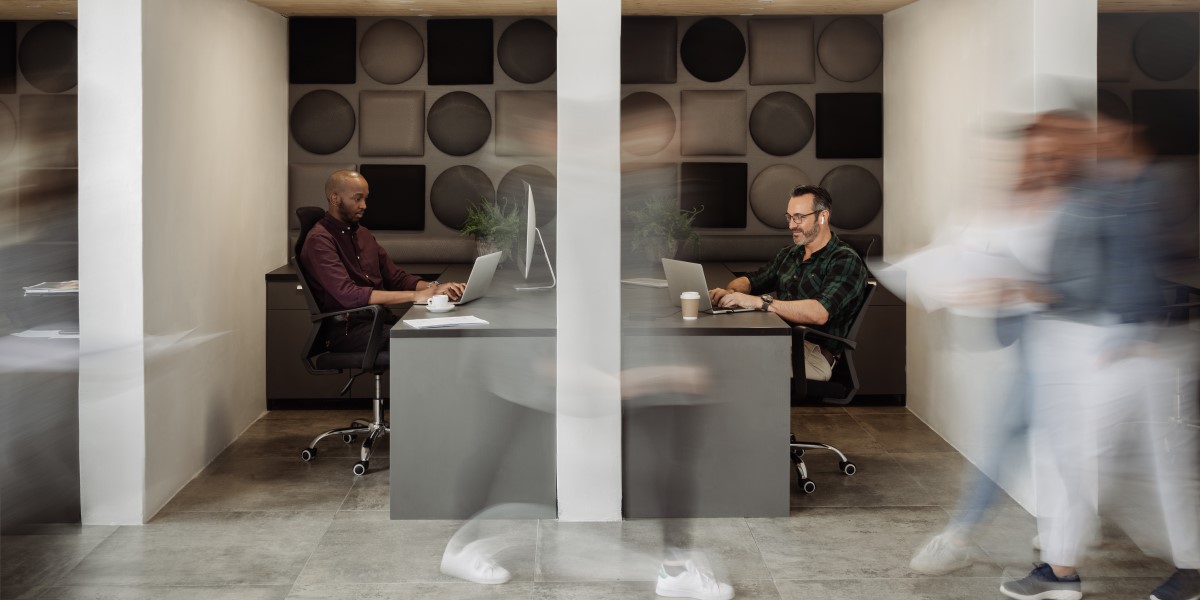If businesses are going to find more success in a hypercompetitive world, they need their facilities to support the greatest range of talent possible. But too often they overlook the needs of neurodivergent people. Now, for the first time, the BSI has published guidelines for inclusive building design, highlighting how to support greater neurodiversity in the workplace.
Why is neurodiversity in the workplace important?
One in seven people have neurodiverse conditions, which can include (but aren’t limited to) autism, Asperger’s, dyslexia and ADHD. People who are neurodiverse may have complex cognitive, sensory and social needs. But they can also possess rare, creative and analytical skills highly prized by modern business.
Neurodiversity is key to future business success
Research into neurodiversity in business by Gartner found:
Neurodivergent workers are wired to think out of the box and are gifted in skills that are essential for digital success. For example, people with ADHD have exceptional focus and problem-solving abilities. Similarly, autistic people are meticulous and have higher analytical thinking.”
This view is echoed in a report from the architectural firm HOK entitled ‘Designing for a Neurodiverse Workplace’. Their Senior Principal and Director of Workplace, Kay Sargent says:
“65% of people that are neurodiverse have above standard intelligence. But 80 to 85% of them are underemployed… because we are not creating environments that are conducive for them to thrive. If we can get that part of it right, then we can tap into this amazing talent pool that is out there that will help business, individuals, and society as a whole”
How traditional workplaces fail neurodiverse workers
Traditional workplaces are notoriously bad at supporting the needs of people with physical disabilities, let alone people with ‘invisible differences’ who can be seriously and negatively affected by the buildings they occupy.
One size fits all building designs are hard to optimise for the different needs of this important segment of users. Much of these requirements centre around having individual control over noise, light, temperature and external distraction. This can represent significant challenges for FM as they try to become more ‘ND engaged’:
- 77% of neurodiverse people are hypersensitive to noise and sound in the workplace
- 62% are hypersensitive to visual distractions (movement, colour, light) in the office
The BSI publishes ‘first of their kind’ guidelines
The new BSI standards use a growing body of research, turning insight into concrete recommendations to design and maintain facilities that can deliver consistency in experience while allowing individuals to adapt and modify spaces to suit their specific needs.
The standard covers guidelines for:
- Lighting
- Acoustics
- Thermal comfort
- Odour control
- Décor
- Flooring
- Layout
- Wayfinding
- Familiarity
- Clarity
Lessons from the front line
Facilities Management in companies which are already supporting neurodiversity have been leading the way in design and management best practices. Looking at the responses of Microsoft, Dell, IBM, and SAP will give many companies ideas for a more inclusive approach in their own workplaces.
As Clare Shepherd, COO of Unispace, points out in this blog post for the Fast Company companies with a successful ND approach offer a ‘menu of intentional choices’ across their spaces - where workers can find different levels of environmental control:
- Quiet desk spaces in low-traffic areas
- Enclosed rooms with minimal clutter and distractions
- Soft seating close to collaborative areas (to retreat between meetings)
- Tech-free zones
- Individual pods to allow for customised workspaces in open-plan spaces
- Adjustments for lighting, colour, and music accommodate diverse needs
- Training for all kinds of workers, including FM, to understand ND needs
What can be done now?
Clare Shepherd points out there are ND-friendly changes that can be done relatively quickly. All it requires is making a few adjustments to the way FM work. She recommends making air quality a priority, as people with neurodiverse conditions are often hypersensitive to odour:
“Ensuring HVAC equipment is serviced properly, and filters changed regularly will facilitate healthy air quality and circulation. Certain plants like palm plants, rubber plants and English ivy make great natural air purifiers, too.”
But there are many aspects of office life that are challenging for neurodiverse people that may be more difficult to appreciate and plan for. For example, some dyspraxic and dyslexic individuals may find navigation in offices difficult where every floor is laid out the same. Shepherd’s advice is to:
“create more unique spaces with visual landmarks and clear lines of sight to help everyone map their own location within a space. This will ultimately save both time and frustration.”
Thinking about ND engagement from an FM perspective is daunting at first, as required changes can seem radical and expensive. But it’s worth spending time educating yourself around this subject and seeing what would be needed to make your office more welcoming and usable for those who are neurodivergent.
This free Creative Differences handbook is an excellent introduction to the subject.
So, why should you care?
“Optimising the work environment to support each individual isn’t just the right thing to do for our people; it’s simply good business.” Kay Sargent, HOK
Skills shortages are dogging British business
Traditional companies are being disrupted by big tech and recession is upon us. Highly skilled individuals who bring new ways of thinking to our workplaces could help many companies navigate these difficult times. But people from the neurodiverse community need support to enter and thrive in the modern office.
Accessibility legislation is likely
Ensuring disabled access is a legal requirement, and it’s only a matter of time before the needs of neurodiverse people are acknowledged in workplace law, too. The BSI guidelines may only foreshadow more formal requirements for equal treatment for those with different needs.
It will benefit everyone
Researchers note that improving choice and control over our working environments can be a huge benefit to everyone. Building inclusive workplaces is about improving experiences for all. As the HOK report points out:
To allow all employees to thrive, office designs need to remain fluid and adaptable. Employers can improve employee wellness and productivity by offering a wide range of choices, allowing people to continually select the best space for their individual needs and the task at hand.”
Conclusion
In a disrupted world, businesses need more people capable of thinking differently and solving problems in new and interesting ways. But traditional offices have served this community poorly, leading to misunderstanding, underperformance, and conflict between many workers and managers.
But the world is changing; accessibility is becoming a key focus for business and a broader regulatory aim. Thinking about neurodiversity as you plan and manage your facilities now could help you open up your business to a greater range of talent in the future.
.png?width=680&height=700&name=Ai%20page%20module%20(2).png)


